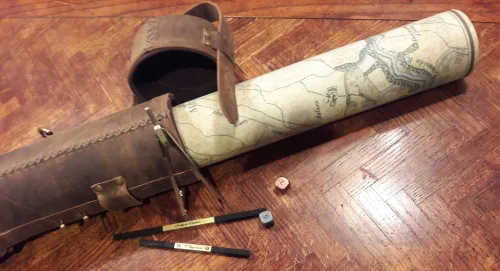
When folks first read and play Pub Battles, one of the most common complaints is that it is too simple. They see the wood blocks and start immediately imagining it’s a regimental level game. They want ranges, and hit points, and weapon types. As a regimental level game, its combat mechanic is very simplified, it is too simple to be truly satisfying, but that is not what the game system is trying to emulate.
The blocks in Pub Battles represent 3,000-6,000 men, and that’s roughly a division in the black powder era. Some really large divisions are represented by 2 blocks. Even that is somewhat misleading. The divisional names are just for color, they don’t actually correlate exactly with the divisions named on the label. It is a mistake to get locked into thinking that this is a divisional level simulation.
Pub Battles is, in the final analysis, a Corps level command focused simulation. At the Corps level, it is quite detailed. Rather than a single block representing the corps, each corps is represented by several independently moving and fighting blocks.
The blocks represent the Corps quite accurately. If a Prussian Corps contained 50% landwehr, then 50% of the blocks in that Corps will be rated militia (Pub Battles’ term for any low-quality brittle troops). Of course, the Landwehr was spread amongst all the Corps’ units, not all in the Divisions matching the labels, but at the Corps level, the model is accurate.
Similarly, a Corps like A.P. Hill’s, might be all reliable troops, and the Corps receives one elite block, to represent its overall efficiency.
Sometimes a Corps will receive an elite, or a militia block because the Corps commander was better, or worse, than other commanders, and the reliability of his Corps reflects that. Usually this isn’t necessary, because the best troops were paired with the best commanders, and vice versa.
To address the original analogy, one should compare Pub Battles with hex and counter systems where the counters represent divisions. There are very few complaints about those games lacking detail. You compare strengths, get an odds ratio, roll the dice, and consult the combat table.
Pub battles is easily as detailed at the divisional level as that, and when you add in the Corps and Army command rules, and the Baggage Trains, it is quite the simulation. It does this with a minimum of rules, and a simple terrain chart that is easily memorized after one game.
The design philosophy with Pub Battles is not how detailed can we make the game, but how few rules can we use to create an authentic command experience? This is much tougher than inventing endless rules for this and that. Creating rules for things is fun and easy, even as those rules degrade the fun and ease of play!
This is what Pub Battles is simulating in my imagination; I’m in the command tent sending out orders (moving my units) and receiving reports (resolving combat). The chit draw simulates the success, or failure, of my officers to carry out my desires, along with any number of an incalculable happenstances that may thwart or augment my plans. All this from a system that is Boom Simple!
What do you think? Is Pub Battles too simple, too complex, or just right?
